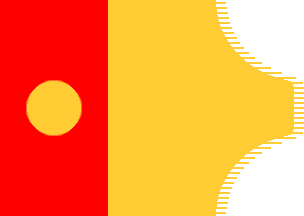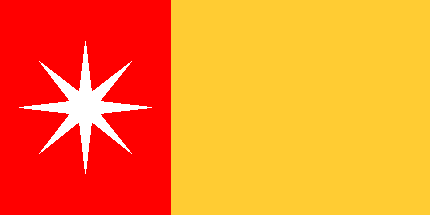
image by Željko Heimer

Last modified: 2007-08-25 by dov gutterman
Keywords: lika | senj | croatia | licko-senjska | st. george | dragon | fort nehaj | falcon | croatian falcon | sokol | star: 8 | segna |
Links: FOTW homepage |
search |
disclaimer and copyright |
write us |
mirrors
See also:
Other Sites:
The coat of arms pictures the saint patron of the city, St.
George killing the dragon. In background there is a silhuete of
the Fort Nehaj, made in such way as to associate to the Croatian
coat of arms. The coat of arms is encirceled in an ornament
including floral and naval elements. The flag is a tricolour of
colours derived from the coat of arms, according to the
Centraleuropean tradition. Both coat of arms and the flag are
aparently against the general rules set by the Ministry of
Administration regarding the local symbols, but it may be that
since those were adopted quite early (1993?) that they were
allowed to stay. In any case, the legal status f those sybols in
uncertain, but they are used nevertheless. Adopted: before 1995
(?).
Source: Tourist leaflet, Tourist Board of the City of
Senj, undated (around 1996). Commemorative coin 5 kuna 1995, 500
years of the printing house in Senj. HRT, 1997
Željko Heimer
The source showing the Coat of Arms (but
not the flag as far as I have noted): is the website of Grad Senj
<http://www.senj.hr>.
Željko Heimer, 6 September 2003

image by Ivan Sarajcic, 2 May 2000
One of the oldest historical source for flag examination is
map. In monography of Historical Institute in Belgrade
"Monumenta Cartographica Jugoslaviae II" Narodna
knjiga, Belgrade 1979. author Gordana Tomovic compares different
XVIth century naval maps of Balkan peninsula. She notices flags
above some place names on map preserved in 'Bibliotheque National
in Paris (Departement des cartes et plans)' made on pergament by
Angelino Dulcert (1339a.d.):
"The flag above Senj (Segna) is verticaly divided, left
field is red with 8-pointed star, and right field is light yellow
(pic.11- Flag above town of
Senj (Segna) - [in today's Croatia yellow star is my guess]).
Similiar heraldic elements could be seen on coats of arms of
dukes Frankopan from Senj and Krk, who ruled Senj from 1271 until
1469...."
Ivan Sarajcic, 2 May 2000
Reading the [isa01], in the
statute of the city of Senj from 14th century it was prescribed
that a ship that enters the port without a flag shall be
financially fined.
Željko Heimer, 17 July 2002

image by Tomislav Todorovic, 4 October 2006
The flag of Senj from the Catalan Atlas differs from the one
from the map of Angelino Dulcert in replacing the star with a
disc and yellow colour with gold. The shape is a square which
extends into a short, wide tongue with concave top and bottom
edges. The disc might have been the result either of the
cartographer's inability to draw a very small star, or of his
insufficient knowledge of the descriptions from "Libro del
conoscimiento de los reinos", as the flag of Senj is
described there as being charged with the eight-pointed star; it
is impossible to decide absolutely certainly nowadays, because
the map contains many flags which are drawn according to the
text, as well as those which considerably differ from their
descriptions.
Tomislav Todorovic, 4 October 2006
Obviously, this is an error in copying and the charge in the
red field should be a golden star (mullet). It is the Coat of
Arms of the most influencial family in Croatian northern Adriatic
coast of the period, the dukes of Krk-Frankapan. The mullet from
their Coat of Arms is included in the number of local Coat of
Arms in Croatia in the rememberance of their lordship. Obviously,
Senj was at the time ruled by the family as well.
Željko Heimer, 14 October 2006

image by Tomislav Todorovic, 27 July 2007
On the map of Guillelmus Soleri, which was created on Majorca
c. 1385, and nowadays is kept in National Library of France,
Paris, the flag of Senj has a very oblong form, with the gold
field much larger than the red one, and the star is white. This
colour combination is actually the one which was described and
depicted in "Libro del conoscimiento de los reinos".
Sources:
- Wigal, Donald: Historic maritime maps used for historic
exploration 1290-1699 Parkstone Press, New York, USA, 2000 ISBN
1-85995-750-1.
- Libro del Conoscimiento. Viajes medievales, vol. I Madrid:
Fundacio'n Jose' Antonio de Castro, 2005 ISBN 84-96452-11-5
(complete edition) ISBN 84-96452-12-3 (vol. I).
Tomislav Todorovic, 27 July 2007

images from Croatian History
Museum site by courtesy of Jelena Borosak Marijanovic
Flag of the Croatian Falcon from Senj - early 20th century
Double silk rep, multicoloured relief silk embroidery and gold
embroidery,
gilt metal strands, wood, metal alloy, tin
138 x 138 cm
From Croatian History Museum
site by courtesy of Jelena Borosak Marijanovic.
Bigger images at <jagor.srce.hr/hpm/m013500v.jpg>
and <m013501v.jpg>.
A square Croatian tricolour edged with golden-yellow fringe
and tassels on the ends. Obverse: the monograph of the Falcon
Society is embroidered in Croatian colours in the centre of the
field. A border with a floral motif runs along the edge of the
field. Reverse: in the centre of the white field the inscription
in gold embroidery reads: HRVATSKI SOKOL / U SENJU. An ornamental
border is embroidered along the edge. The staff has a finial in
the shape of a falcon with spread wings. The flag is fixed to the
staff with gilt studs with the names of sponsors and the names of
societies.
J. Borosak-Marijanovic, Zastave kroz stoljeca, Zagreb,
1996, catalogue number 119, page 153.
The Falcon (Sokol) society is a (kind of) sporting society of
a great importance in Croatian history as it promoted national
identity and feeling, together with a sporting spirit. There were
such societies in almost all Croatian cities from (IIRC) end of
19th century, and many of those flags are preserved. Many of
those flags followed similar pattern to this one, though there
were others too.
Željko Heimer, 29 September 1999